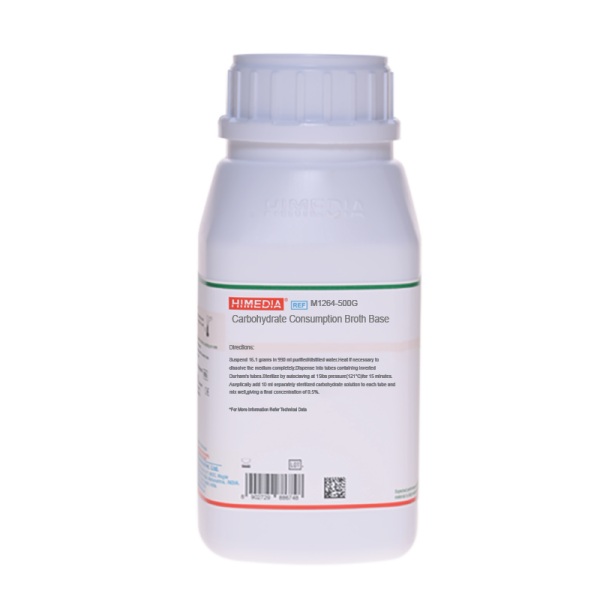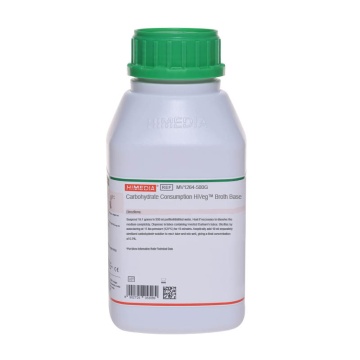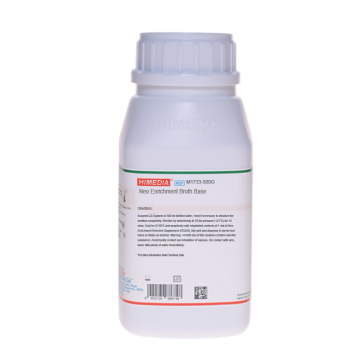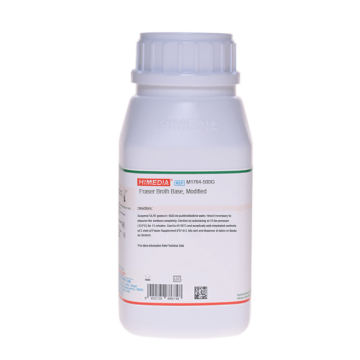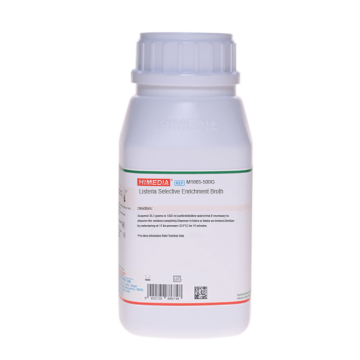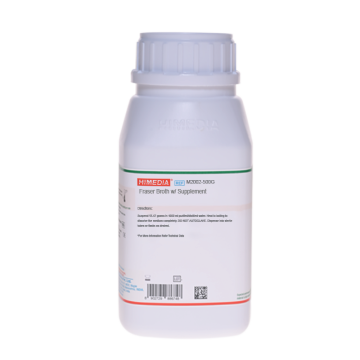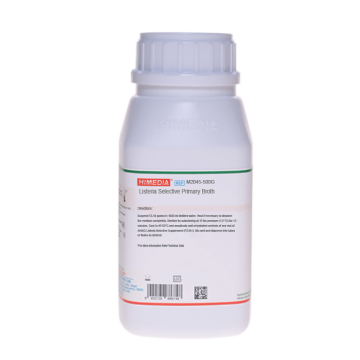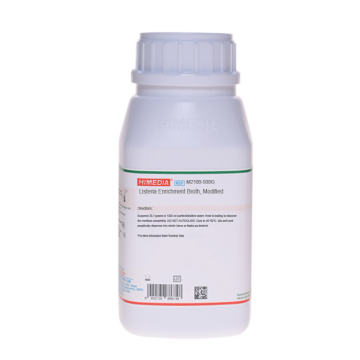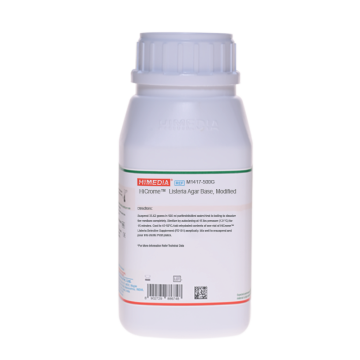 Your enquiry has been submitted
Your enquiry has been submitted
Carbohydrate Consumption Broth Base
Listeria#CC293D
Intended Use
Recommended for cultivation and differentiation of Listeria species.
Composition
| Ingredients | Gms/Litre |
|---|---|
| Proteose peptone | 10.000 |
| Sodium chloride | 5.000 |
| HM peptone B # | 1.000 |
| Bromocresol purple | 0.100 |
Final pH (at 25°C): 6.8±0.2
Formula adjusted, standardized to suit performance parameters
# - Equivalent to Beef extract
Directions
Suspend 16.1 grams in 990 ml purified / distilled water. Heat if necessary to dissolve the medium completely. Dispense into tubes containing inverted Durhams tubes. Sterilize by autoclaving at 15 lbs pressure (121°C) for 15 minutes. Aseptically add 10 ml separately sterilized carbohydrate solution to give a final concentration of 0.5%. Mix well.
Principle And Interpretation
Carbohydrate Consumption Broth is used for the cultivation and differentiation of Listeria species and formulated as per Atlas (2). It is also recommended by FDA (3) and ISO (4) with a slight difference in the concentration of bromocresol purple. Differentiation is based on fermentation of glucose, xylose, rhamnose, ribose, a-methyl-D-mannoside and mannitol. Proteose peptone and HM peptone B in the medium provide carbon and nitrogen compounds including essential amino acids, vitamins and trace ingredients for bacterial metabolism. Bromocresol purple is the pH indicator, which indicates acid production by turning yellow in colour.
Carbohydrate utilization test: Inoculate each kind of carbohydrate fermentation broth with one loopful of inoculum. Incubate for 7 days at 37°C. Observe daily for acid induced colour change and gas formation. Sometimes weak positive reactions may occur after 48 hours of incubation (3).
Type of specimen
Isolated Microorganism from food samples.
Specimen Collection and Handling
For food and dairy samples, follow appropriate techniques for sample collection and processing as per guidelines (1,7,8). After use, contaminated materials must be sterilized by autoclaving before discarding.
Limitations
NA
Performance and Evaluation
Performance of the medium is expected when used as per the direction on the label within the expiry period when stored at recommended temperature.
Quality Control
Appearance Light yellow to beige homogeneous free flowing powder
Colour and Clarity of prepared medium Purple coloured, clear solution without any precipitate
Reaction Reaction of 1.61% w/v aqueous solution at 25°C. pH: 6.8±0.2
pH 6.60-7.00
Cultural Response
Cultural characteristics observed after an incubation at 35-37°C for 18-48 hours.
| Organism | Inoculum (CFU) | Growth | w/o carbohydrate acid | w/o carbohydrate gas | w/ rhamnose (acid) | w/ rhamnose (gas) |
|---|---|---|---|---|---|---|
| Escherichia coli ATCC 25922 (00013*) | 50-100 | good-luxuriant | negative reaction, no colour change | negative reaction | positive reaction, yellow colour | positive reaction |
| Listeria monocytogenes subsp. serovar 1 ATCC 19111 (00020*) | 50-100 | good-luxuriant | negative reaction, no colour change | negative reaction | positive reaction, yellow colour | negative reaction |
| Listeria monocytogenes ATCC 19112 | 50-100 | good-luxuriant | negative reaction, no colour change | negative reaction | positive reaction, yellow colour | negative reaction |
| Listeria monocytogenes ATCC 19117 | 50-100 | good-luxuriant | negative reaction, no colour change | negative reaction | positive reaction, yellow colour | negative reaction |
| Staphylococcus aureus ATCC 25923 (00034*) | 50-100 | good-luxuriant | negative reaction, no colour change | negative reaction | negative reaction, no colour change | negative reaction |
| Listeria monocytogenes ATCC 19118 | 50-100 | good-luxuriant | negative reaction, no colour change | negative reaction | positive reaction, yellow colour | negative reaction |
Key: *Corresponding WDCM numbers.
Storage and Shelf Life
Store between 10-30°C in a tightly closed container and the prepared medium at 2-8°C. Use before expiry date on the label. On opening, product should be properly stored dry, after tightly capping the bottle in order to prevent lump formation due to the hygroscopic nature of the product. Improper storage of the product may lead to lump formation. Store in dry ventilated area protected from extremes of temperature and sources of ignition Seal the container tightly after use.
Product performance is best if used within stated expiry period.
Disposal
User must ensure safe disposal by autoclaving and/or incineration of used or unusable preparations of this product. Follow established laboratory procedures in disposing of infectious materials and material that comes into contact with clinical sample must be decontaminated and disposed of in accordance with current laboratory techniques (5,6).
Reference
- American Public Health Association, Standard Methods for the Examination of Dairy Products, 1978, 14th Ed., Washington D.C.
- Atlas R. M., 2004, Handbook of Microbiological Media, 3rd Edition, CRC Press, Washington D. C.
- FDA Bacteriological Analytical Manual, 2005, 18th Ed., AOAC, Washington, D.C.
- International Organization for Standardization (ISO), 1993, Draft ISO/DIS 10560.
- Isenberg, H.D. Clinical Microbiology Procedures Handbook 2nd Edition.
- Jorgensen, J.H., Pfaller, M.A., Carroll, K.C., Funke, G., Landry, M.L., Richter, S.S and Warnock., D.W. (2015) Manual of Clinical Microbiology, 11th Edition. Vol. 1.
- Salfinger Y., and Tortorello M.L., 2015, Compendium of Methods for the Microbiological Examination of Foods, 5th Ed., American Public Health Association, Washington, D.C.
- Wehr H. M. and Frank J. H., 2004, Standard Methods for the Microbiological Examination of Dairy Products, 17th Ed., APHA Inc., Washington, D.C.
| Product Name | Carbohydrate Consumption Broth Base |
|---|---|
| SKU | M1264 |
| Product Type | Regular |
| Physical Form | Powder |
| Origin | Animal |
| Packaging type | HDPE |
| References | 1. American Public Health Association, Standard Methods for the Examination of Dairy Products, 1978, 14th Ed.,Washington D.C |
| Customized Product Available | No |



